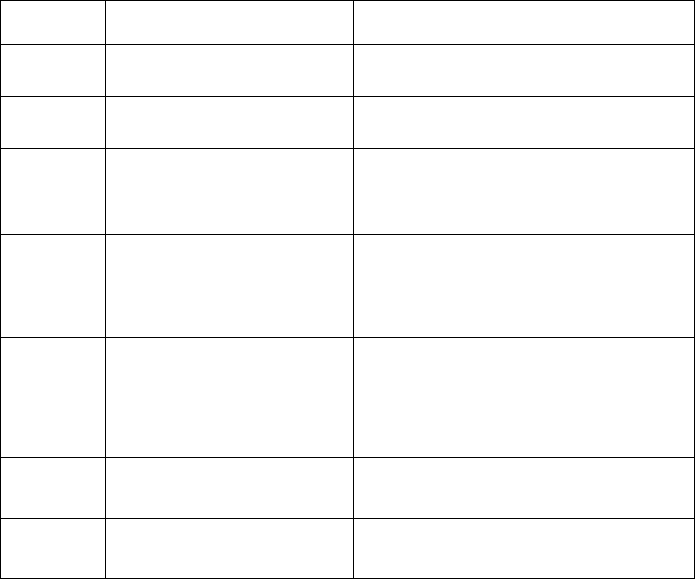User manual
Table Of Contents
- 1. INTENDED USE
- 2. PRECAUTIONARY MEASURES
- 3. WARRANTY CONDITIONS
- 4. UNPACKING AND MOUNTING
- 5. CONSTRUCTION
- 6. GETTING STARTED
- 7. KEYPAD OVERLAY
- 8. FUNCTIONS OF KEYS
- 9. PROGRAM STRUCTURE
- 10. INDICATING WINDOW
- 11. LOGGING ON
- 12. NAVIGATING WITHIN THE MENU
- 13. WEIGHING
- 14. SCALE PARAMETERS
- 15. COMMUNICATION
- 16. DEVICES
- 17. DISPLAY
- 18. INPUTS / OUTPUTS
- 19. AUTHORIZATION
- 20. OTHER PARAMETERS
- 21. CUSTOMER CALIBRATION
- 22. SPECIAL FUNCTIONS OF WORKING MODES
- 23. WORK MODE - WEIGHING
- 24. WORKING MODES – COUNTING PIECES
- 25. WORKING MODES – DEVIATIONS
- 26. WORKING MODES – COMPARATOR
- 27. DATABASES
- 28. COMMUNICATION PROTOCOL
- 28.1. General information
- 28.2. Inventory of RS commands
- 28.3. Respond message format
- 28.4. Command’s description
- 28.4.1. Zeroing
- 28.4.2. Tarring
- 28.4.3. Get tare value
- 28.4.4. Set tare value
- 28.4.5. Send the stable result in basic unit
- 28.4.6. Send the result immediately in basic unit
- 28.4.7. Send the stable result in current unit
- 28.4.8. Send the result immediately in current unit
- 28.4.9. Switch on continuous transmission in basic unit
- 28.4.10. Switch off continuous transmission in basic unit
- 28.4.11. Switch on continuous transmission in current unit
- 28.4.12. Switch off continuous transmission in current unit
- 28.4.13. Set lower threshold
- 28.4.14. Set upper threshold
- 28.4.15. Read lower threshold
- 28.4.16. Read upper threshold
- 28.4.17. Send all implemented commands
- 28.5. Manual printouts / automatic printouts
- 29. CONNECTING EXTERNAL DEVICES
- 30. DIAGRAMS OF CONNECTION CABLES
- 31. TECHNICAL PARAMETERS
- 32. ERROR MESSAGES
- 33. ADDITIONAL EQUIPMENT
- 34. APPENDIX A – Variables for printouts
- 35. APPENDIX B – Functions of programmable buttons
- 36. APPENDIX C – Label pattern
- 37. APPENDIX D - CITIZEN printer setting
- 38. APPENDIX E - ZEBRA printer setting
- 39. APPENDIX F - Communication with barcode scanners

106
34.2. Formatting variables
Users can format numeric, text and date variables intended for displaying
or printing out.
Different format commands:
• Justification to the left,
• Justification to the right,
• Setting the number of characters for printout / display,
• Declaration of the number of digital places for numeric variables,
• Date&Time formatting,
• Formatting numeric variables for EAN13 codes,
• Formatting numeric variables and dates for EAN128/GS1-128 codes.
Format characters:
Character Description Example
, Separates veriables from
format strings
{7,10} – Net mass in calibration unit situated
in 10-character string justified to the right.
- Minus sign or justification to the
left
{7,-10} - Net mass in calibration unit situated
in 10-character string justified to the left
: Precides formatting or
sepatates hours, minutes and
seconds
{7:0.000} - Net mass in calibration unit
always with three decimal places ;
{3:hh:mm:ss} – Present time in the format :
hours : minutes : seconds
. The first dot in the format string
determines the location of the
decimal separator in the
formatted value; any additional
dot characters are ignored.
{55:0.00} – Unit price always with two
decimal places;
{17:0.0000} – Average value form weighings
with four decimal places;
F The number is converted to a
string of the form "-ddd.ddd…"
where each 'd' indicates a digit
(0-9). The string starts with a
minus sign if the number is
negative.
{7:F2} - Net mass in calibration unit always
with two decimal places.
{7,9:F2} - Net mass in calibration unit always
with two decimal places in 9-character string
justified to the right.
V Formatting mass and
derivatives for EAN13 codes
{7:V6.3} - Net mass for EAN13 (6-character
code) with three decimal characters
T Formatowanie masy i wielkości
pochodnych do masy w kodzie
EAN128
{7:T6.3} – Net mass for EAN128/GS1-128
with two decimal places.










